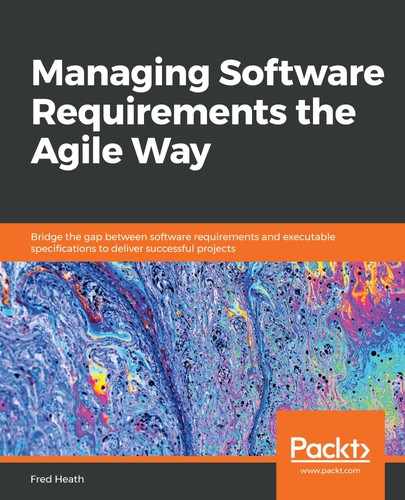Table of Contents
Preface
Chapter 1: The Requirements Domain
The nature of requirements and specifications 2
What is a requirement? 3
What are specifications? 3
The requirements life cycle 4
Identifying stakeholders 5
Identifying goals 7
Domain goals 7
Business goals 8
A traveling analogy of goals, requirements, and specifications 13
Crossing from requirements to specifications 14
The requirements funnel 14
The user story chaos 16
Summary 17
Further reading 17
Chapter 2: Impact Mapping and Behavior-Driven Development
Modeling requirements with impact maps 20
Introduction to impact mapping 20
The benefits of impact mapping 21
Identifying capabilities and features 22
What is a capability? 24
What is a feature? 24
Distinguishing capabilities from features 25
Introducing BDD 30
BDD with impact mapping – a perfect partnership 32
Knowing the difference between functional and non-functional requirements 32
Summary 34
Further reading 35
Chapter 3: Writing Fantastic Features with the Gherkin Language
What's in a feature? 38
Writing Features with Gherkin 39
Scripting Scenarios 41
Discovering Scenarios 42
Avoiding repetition with Data Tables 44
Adding more Scenarios 45
Avoiding repetition with Scenario Outlines 46
Scenario Outlines versus Data Tables 48
Avoiding step repetition with Backgrounds 49
Writing a fully formed Feature 50
Tips for writing good Features 52
Using tags to label, organize, and filter our Features 54
Knowing why Features are executable specifications 55
Summary 58
Further reading 59
Chapter 4: Crafting Features Using Principles and Patterns
Applying the BDD principles 62
BDD isn't testing 62
The 80-20 rule 62
System behavior is not system implementation 63
Wearing different hats 64
Discerning patterns in our features 64
The CRUD Features pattern 65
The composite features pattern 66
The feature interpolation pattern 68
Patterns to avoid 71
Anti-pattern – thinking like developers 72
Anti-pattern – incidental details 73
Anti-pattern – scenario flooding 74
Anti-pattern – vague outcomes 74
Anti-pattern – compound steps 76
Summary 77
Chapter 5: Discovering and Analyzing Requirements
The lost art of requirements elicitation 80
Preparing for requirements analysis 82
Stakeholder model 82
Glossary 85
Analyzing requirements 87
Having a structured conversation 88
Decompose, Derive, Discover (D3) 89
Decomposition 90
Detecting capabilities and features 91
Decomposition outcome 93
Derivation 94
Discovery 95
Business process mapping 96
Summary 99
Chapter 6: Organizing Requirements
Providing easy access to our requirements model 102
Ensuring traceability with entity identifiers 103
Creating a specification document 104
Getting stakeholder agreement on the specification 106
Scoping the specification 106
Creating a product backlog 107
The Agile SDLC 107
What goes into the product backlog? 108
Where to keep the backlog 112
Summary 113
Chapter 7: Feature-First Development
Setting up for successful delivery 116
Creating a staging environment 116
Creating a task board 116
Defining done 118
Actualizing just-in-time development 119
Working with Scrum 120
Sprint planning 121
Sprint development cycle 122
End of Sprint 125
Dealing with change 128
Working within Kanban 132
Kanban planning 133
Kanban development cycle 134
Dealing with change 135
Summary 135
Chapter 8: Creating Automated Verification Code
Why is automated verification valuable? 138
Avoiding brittleness by layering automation code 138
The brittle step definition problem 139
Applying layers of abstraction 140
Leveraging automated verification code patterns 142
Hiding browser details with the Page Object pattern 143
Wrap up complex operations with the Façade Pattern 146
Knowing which patterns to apply and when to apply them 147
Separating the things we verify from the way we verify them 148
Summary 149
Chapter 9: The Requirements Life Cycle
Revisiting the requirements management life cycle 152
Validating requirements 153
Modeling requirements 153
Creating specifications 155
Classifying requirements 156
Documenting requirements 157
Prioritizing requirements 157
Verifying requirements 159
Dealing with change 159
Applying the Agile requirements management workflow 163
Elicitation and Analysis 163
Modeling and Discovery 165
Executable specification 166
Development, Validation, and Verification 167
Summary 168
Further reading 168
Chapter 10: Use Case: The Camford University Paper Publishing System
Understanding the Camford conundrum 170
Eliciting requirements 171
Leading the initial discussions 171
Analyzing requirements 174
Decomposing the ME's requirements 177
Deriving requirements 179
Discovering requirements 180
Planning the way forward 182
Summary 184
Other Books You May Enjoy
Leave a review - let other readers know what you think 189
..................Content has been hidden....................
You can't read the all page of ebook, please click here login for view all page.
